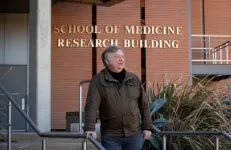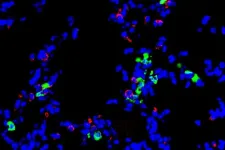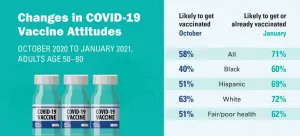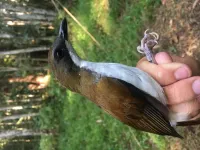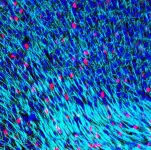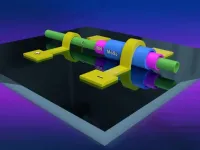(Press-News.org) RIVERSIDE, Calif. -- Variants of the coronavirus are appearing in different parts of the world, many of them spreading with alarming speed. One contagious variant is the South African, or SA, variant, identified by an international team of researchers, including biomedical scientists from the University of California, Riverside.
"The new COVID-19 variants are the next new frontier," said Adam Godzik, a professor of biomedical sciences in the UC Riverside School of Medicine and a member of the research team that made the discovery. "Of these, the SA and Brazil strains are most worrying. They have mutations that make them resistant to antibodies we generate with existing vaccines. It is commonly believed we are in a tight race: Unless we vaccinate people quickly and squash the pandemic, new variants would dominate to the point that all our COVID-19 vaccines would be ineffective."
Godzik and Arghavan Alisoltani-Dehkordi, a postdoctoral researcher who joined his lab two years ago, helped characterize the new SA variant by providing its spike protein structure using computer simulations.
Study results appear today in Nature.
Alisoltani-Dehkordi, who was a postdoctoral fellow at the University of Cape Town in South Africa before she joined UCR, mentioned that research teams at the University of KwaZulu-Natal in South Africa and the University of Cape Town discovered the new lineage -- or variant -- of SARS-CoV-2, the virus that causes COVID-19, from samples collected between Oct. 15 and Nov. 25, 2020, in three South African provinces. By early November, this variant rapidly became the dominant variant in samples from two provinces.
"Each SARS-CoV-2 variant has specific mutations defining it," Alisoltani-Dehkordi said. "Professor Godzik and I used computer modeling to suggest possible structural and functional consequences of spike protein mutations in the SA lineage. Our analysis, confirmed also by several other research groups, shows that some of the mutations potentially result in a higher transmissibility of the virus and a weaker immune response."
The SA variant has been detected in at least 40 countries, including the United States.
"This variant is probably spreading in areas where it has not been sequenced and is, therefore, not identifiable," Godzik said. "In the U.S., sequencing is still a slow process. In many parts of the country, including Riverside, we have no information whatsoever about variants."
Initial research on the SA variant suggested it could be resistant to antibodies, which could reduce the efficacy of vaccines.
"That's when it received a high level of interest," Godzik said. "Subsequent research confirmed it is resistant to vaccines and is spreading. South Africa is doing a good job, however, at controlling the variant through quarantining and other measures."
All the newly emerged SARS-CoV-2 variants of concern in the United Kingdom, South Africa, Brazil, and California show common mutational signatures. But each of these variants also has a unique set of mutations. For example, the SA and Brazil variants have two unique mutations on spike proteins K417N and E484K, respectively.
"Our preliminary findings indicate that some of the spike mutations may be associated with increased transmissibility of the SA variant," Alisoltani-Dehkordi said. "The full significance of spike and other genome mutations in this new lineage, however, is yet to be determined. It needs to be stressed that we do not have enough evidence confirming the higher disease progression, severity, or mortality rate associated with the SA lineage compared to other lineages. But the high transmissibility and unusual divergence of the SA lineage and other recently emerged lineages compared to the wild type creates a high demand for the systematic surveillance of SARS-CoV-2 strains and early detection of variants before they turn into outbreaks."
Godzik explained there is no single COVID-19 virus. Instead, a population of viruses exists that constantly evolve. Variants, which also evolve, acquire mutations and could undergo viral escape at any time.
"It is hard to say there is only one SA variant," he said. "One way to understand this is to imagine that this variant is the major branch of a tree, which has many smaller branches. Some of these smaller ones may grow faster than others and assume more importance. This dynamic process is hard to predict."
Godzik predicts COVID-19 will be a constant presence in our lives, much like the flu.
"It takes six months to develop a flu vaccine," he said. "Models predict the evolution of the flu virus and vaccines are produced before the variants show up. If the predictions are good, the vaccines work. If they miss, a heavy flu season follows. This is how COVID-19 will likely behave. A lot of effort will be invested in predicting what will happen the following year, vaccines would then be updated, and people will need to get a booster shot."
INFORMATION:
The research paper is titled "Emergence of a SARS-CoV-2 variant of concern with mutations in spike glycoprotein."
The University of California, Riverside (http://www.ucr.edu) is a doctoral research university, a living laboratory for groundbreaking exploration of issues critical to Inland Southern California, the state and communities around the world. Reflecting California's diverse culture, UCR's enrollment is more than 25,000 students. The campus opened a medical school in 2013 and has reached the heart of the Coachella Valley by way of the UCR Palm Desert Center. The campus has an annual statewide economic impact of almost $2 billion. To learn more, email news@ucr.edu.
Scientists at Washington University School of Medicine in St. Louis have implicated a type of immune cell in the development of chronic lung disease that sometimes is triggered following a respiratory viral infection. The evidence suggests that activation of this immune cell -- a type of guardian cell called a dendritic cell -- serves as an early switch that, when activated, sets in motion a chain of events that drives progressive lung diseases, including asthma and chronic obstructive pulmonary disease (COPD).
The new study, published in The Journal of Immunology, opens the door to potential preventive ...
New study finds the skyrocketing cost of drugs in U.S. used to treat hookworm and other soil-transmitted parasites increases patient costs, suggests decreased quality of care
A new study finds that the increasingly high prices in the United States of the drugs used to treat three soil-transmitted helminth infections--hookworm, roundworm (ascariasis), and whipworm (trichuriasis)--is not only the major driver for the increase in costs to patients with either Medicaid or private insurance, but it also may have a damaging impact on the quality-of-care patients receive as clinicians shift their prescribing patterns to more affordable yet less-effective medicines covered ...
https://doi.org/10.15212/bioi-2021-0002
Announcing a new article publication for BIO Integration journal. In this article the authors Jingdun Xie, Zhenhua Qi, Xiaolin Luo, Fang Yan, Wei Xing, Weian Zeng, Dongtai Chen and Qiang Li; from Sun Yat-sen University, Guangzhou, Guangdong, China discuss integration analysis of m6A regulators and m6A-related genes in hepatocellular carcinoma (HCC).
N6-Methyladenosine (m6A) RNA methylation of eukaryotic mRNA is involved in the progression of various tumors. This study comprehensively analyzed m6A regulators and m6A-related genes through an integrated bioinformatic analysis, ...
Last fall, nearly half of older adults were on the fence about COVID-19 vaccination - or at least taking a wait-and-see attitude, according to a University of Michigan poll taken at the time.
But a new follow-up poll shows that 71% of people in their 50s, 60s and 70s are now ready to get vaccinated against COVID-19 when a dose becomes available to them, or had already gotten vaccinated by the time they were polled in late January. That's up from 58% in October.
Three groups of older adults with especially high risk of severe COVID-19 -- Blacks, Hispanics and people in fair or poor health - had even bigger jumps in vaccine receptiveness between October and late January.
The poll shows a 20-point jump in just ...
BOSTON - Almost immediately after the first mRNA-based COVID-19 vaccines were authorized for emergency use and were administered to individuals outside of clinical trials, reports of anaphylaxis--a life-threatening whole-body allergic reaction--raised widespread concerns among experts and the public. Now, real world data on vaccinations among employees at Mass General Brigham provide reassurances of the rarity of such serious reactions, and the ability to recover from them. The findings are published in the END ...
Past studies on whether incarcerated people with mental illness are more likely to be placed in solitary confinement have yielded mixed results. A new study examined the issue in one state's prisons, taking into account factors related to incarcerated men and the facilities where they were imprisoned. It found that having a mental illness was associated with a significant increase in the likelihood of being placed in extended solitary confinement.
The study, by researchers at Florida State University (FSU), appears in Justice Quarterly, a publication of the Academy of Criminal Justice Sciences.
"Our findings provide new information on how mental illness shapes experiences for incarcerated men, and more broadly, on how the criminal justice ...
A research team at Johannes Gutenberg University Mainz (JGU) in Germany has developed a completely new, environmentally-friendly electrochemical procedure for producing sulfonamides rapidly and inexpensively. Sulfonamides are used in many drugs including antibiotics and Viagra as well as in agrochemicals and dyes, which makes them an important class of molecules for the pharmaceutical and chemical industries. While to date it has been necessary to use corrosive chemicals, high temperatures, and expensive metal catalysts to produce sulfonamides, the new method requires ...
The mountain forests of Tanzania are more than 9,300 miles away from Salt Lake City, Utah. But, as in eastern Africa, the wild places of Utah depend on a diversity of birds to spread seeds, eat pests and clean up carrion. Birds keep ecosystems healthy. So if birds in Tanzania are in trouble in a warming climate, as found in a recent study by University of Utah researchers, people in Utah as well as in the African tropics should pay attention.
In a new study published in Global Change Biology, doctoral student Monte Neate-Clegg and colleagues tracked the demographics of 21 bird species over 30 years of observations from a mountain forest in Tanzania. For at least six of the species, their population declined over ...
A new study led by the University of Portsmouth has identified that one of the major factors of age-related brain deterioration is the loss of a substance called myelin.
Myelin acts like the protective and insulating plastic casing around the electrical wires of the brain - called axons. Myelin is essential for superfast communication between nerve cells that lie behind the supercomputer power of the human brain.
The loss of myelin results in cognitive decline and is central to several neurodegenerative diseases, such as Multiple Sclerosis and Alzheimer's disease. This new study found that the cells that drive myelin repair become less efficient as we age and identified a key gene that is most affected by ageing, which reduces the ...
The recent synthesis of one-dimensional van der Waals heterostructures, a type of heterostructure made by layering two-dimensional materials that are one atom thick, may lead to new, miniaturized electronics that are currently not possible, according to a team of Penn State and University of Tokyo researchers.
Engineers commonly produce heterostructures to achieve new device properties that are not available in a single material. A van der Waals heterostructure is one made of 2D materials that are stacked directly on top of each other like Lego-blocks or a sandwich. The van der Waals force, which is an attractive force between uncharged molecules or atoms, holds the materials together.
According to Slava V. Rotkin, Penn State Frontier ...
